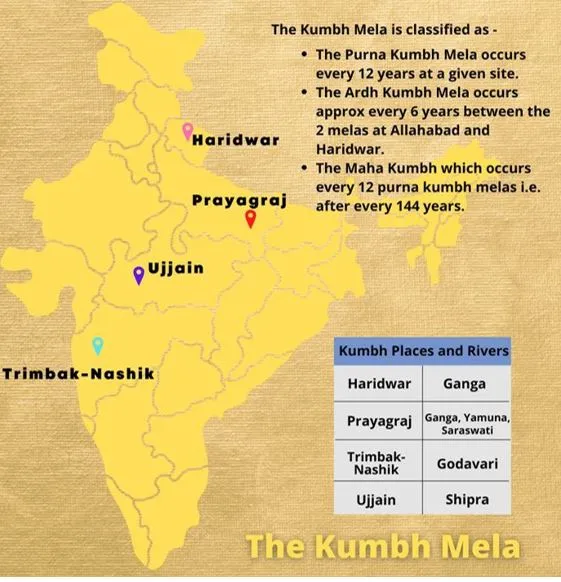

13th January 2025 (11 Topics)
Context
Prayagraj is hosting the Maha Kumbh (Poorna Kumbh), the world's largest religious congregation, held every 12 years. The 45-day Maha Kumbh, happening after a gap of 144 years, started at Triveni Sangam, the confluence of the Ganga, Yamuna, and the mythological Saraswati rivers
About Kumbh Mela
- The Kumbh Mela is one of the largest religious gatherings in the world, held at four locations in India:
- Haridwar
- Prayagraj (also known as Allahabad)
- Ujjain
- Nashik
- Types of Kumbh Mela
- Maha Kumbh or Poorna Kumbh: Held every 12 years at each of the four locations. It is the grandest of the Kumbh Melas, attracting millions of devotees.
- Ardh Kumbh: Held every 6 years, at Prayagraj and Haridwar. It is a smaller version but still highly significant.
- The word "Kumbh" means "pitcher" or "pot." The story behind the Kumbh Mela comes from Hindu mythology.
-
- According to the myth, gods (Devas) and demons (Asuras) churned the ocean to obtain amrita (the elixir of immortality). During this process, Dhanvantri, the god of medicine, emerged holding a pitcher of amrita.
- To prevent the demons from getting it, the gods' leader, Indra’s son Jayant, ran away with the pitcher.
- As Jayant fled, some of the amrita spilled at four locations—Haridwar, Prayagraj, Ujjain, and Nashik.
- These locations are believed to have gained spiritual significance due to this myth. As the gods and demons fought over the pot for 12 days, each day for them was equal to a year for humans.
- This is why Kumbh Mela is celebrated every 12 years, corresponding to the relative positions of the Sun, Moon, and Jupiter in the sky.
- The festival's large-scale organization is often attributed to Hindu philosopher Adi Shankaracharya in the 8th century, who established periodic religious gatherings at these four river banks.
- The rivers associated with the Kumbh Mela—Ganga (Haridwar, Prayagraj), Kshipra (Ujjain), and Godavari (Nashik)—are considered sacred in Hinduism.
Astrological Significance
- The timing of the Kumbh Mela is determined by astrological factors. The festival is celebrated when Jupiter is in specific zodiac signs and when the Sun and Moon align in certain constellations.
- Haridwar: When Jupiter is in Aquarius (Kumbh Rashi), and the Sun and Moon are in Aries and Sagittarius.
- Prayagraj: When Jupiter is in Taurus, and the Sun and Moon are in Capricorn.
- Ujjain and Nashik: When Jupiter is in Leo, and the Sun and Moon are in Cancer.
- The position of these celestial bodies is believed to have special power, making the Kumbh Mela a spiritually significant event for pilgrims.
More Articles


